The European Wold Newton Universe
(with divers disquisitions and holdings-forth on matters obscure,
arcane, and mischievous,
and an occasional diversion into English and American personages)
Timeline
(Before 1800)
Updated 10 May; updates in blue.
c. 60-c. 30 B.C.E. Tros of Samothrace, the son of
Prince Perseus, fights against Rome. Tros is a leader of men, a military captain,
clever as a leader and driven by honor to do right by those who serve him.
He is also a master seaman, among the best sailors of his day. Tros fights
his way around the Mediterranean, sending many Romans down to the briny deep;
Tros hates Julius Caesar, who is a "liar, a brute, a treacherous humbug and
conceited ass." Tros fights Northmen and Briton, eventually marrying one
of the former and bringing both groups around to his side. He builds the
Liafail, a massive ship of his own unique design, filled with special
armaments for Greek Fire. He cons Caesar into making him his Admiral. He
stops conspiracies in Spain. In Rome he helps pressure Caesar into abandoning
an invasion of Spain (though not after having to fight in the Circus Maximus).
He acquires the disfavor of Cleopatra and has to carry out tasks for her,
squashing conspiracies and intrigues, some by her sister. He ends up marrying
Arsinoe, the sister (his first wife was killed while a prisoner), earning
him the wrath of Cleopatra (she burns Liafail, for one). Tros helps
Marc Anthony defeat Brutus and Cassius, and Anthony gets Cleopatra off his
back. (Talbot Munday's Tros of Samothrace stories, beginning with "Tros
of Samothrace" in 1925).
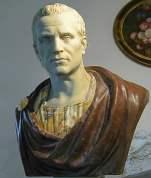 65-66 C.E. In Rome Vinicius, a Roman soldier, meets the maiden
Lygia, the daughter of a barbarian prince. Vinicius falls in love with
Lygia and through love of her eventually converts to Christianity. Meanwhile,
Vinicius’ friend Petronius negotiates his way through the deadly
politics of the court of Nero. He is known as "Petronius Arbiter" because
of his superb taste in art and aesthetics. Nero orders Rome set on fire
and begins persecuting the new cult of Christianity. Lygia is captured
but eventually freed, and Lygia and Vinicius marry and flee to Sicily.
The rogue manhunter Chilo Chilonides eventually escapes from Rome as well.
Petronius is not so lucky, although he could at any time depose Tigellinus,
the leader of the soldiers, and take command of the Roman army. (Such would
be too much effort for Petronius, who is content instead to stay in his
villa, admire his works of art, and read the classics. Knowing that he is
about to be condemned to death by Nero, Petronius holds a lush feast for
those he values. At the end of the feast he slits his wrist and then reads
a savage condemnation of Nero’s personality and artistic abilities. Petronius
dies in the arms of Eunice, his love. (Henryk Sienkiewicz's Quo Vadis,
1895).
65-66 C.E. In Rome Vinicius, a Roman soldier, meets the maiden
Lygia, the daughter of a barbarian prince. Vinicius falls in love with
Lygia and through love of her eventually converts to Christianity. Meanwhile,
Vinicius’ friend Petronius negotiates his way through the deadly
politics of the court of Nero. He is known as "Petronius Arbiter" because
of his superb taste in art and aesthetics. Nero orders Rome set on fire
and begins persecuting the new cult of Christianity. Lygia is captured
but eventually freed, and Lygia and Vinicius marry and flee to Sicily.
The rogue manhunter Chilo Chilonides eventually escapes from Rome as well.
Petronius is not so lucky, although he could at any time depose Tigellinus,
the leader of the soldiers, and take command of the Roman army. (Such would
be too much effort for Petronius, who is content instead to stay in his
villa, admire his works of art, and read the classics. Knowing that he is
about to be condemned to death by Nero, Petronius holds a lush feast for
those he values. At the end of the feast he slits his wrist and then reads
a savage condemnation of Nero’s personality and artistic abilities. Petronius
dies in the arms of Eunice, his love. (Henryk Sienkiewicz's Quo Vadis,
1895).
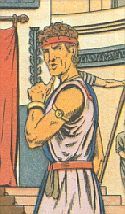 79. In Pompeii in the days before the eruption of Mount Vesuvius,
one man, above all others, is a figure of fear and respect: Arbaces,
"the Lord of the Burning Girdle." He is an Egyptian living in Pompeii.
A magician, he claims to be “he...from whom all cultivators of magic, from
north to south, from east to west, from the Ganges and the Nile to the
vales of Thessaly and the shores of the yellow Tiber, have stooped to learn.”
Worshipers of the Egyptian pantheon look to him as a priest, confessor,
and father figure; those who are not worshipers fear him, because he is
widely rumored to wield the Evil Eye. He has contacts everywhere, especially
among the Priests of Isis, whose chief Calenus is his servant and into
whose company Arbaces personally inducts a number of priests. None of this
is enough to save him when Vesuvius erupts, however. (Edward Bulwer-Lytton's
The Last Days of Pompeii, 1834).
79. In Pompeii in the days before the eruption of Mount Vesuvius,
one man, above all others, is a figure of fear and respect: Arbaces,
"the Lord of the Burning Girdle." He is an Egyptian living in Pompeii.
A magician, he claims to be “he...from whom all cultivators of magic, from
north to south, from east to west, from the Ganges and the Nile to the
vales of Thessaly and the shores of the yellow Tiber, have stooped to learn.”
Worshipers of the Egyptian pantheon look to him as a priest, confessor,
and father figure; those who are not worshipers fear him, because he is
widely rumored to wield the Evil Eye. He has contacts everywhere, especially
among the Priests of Isis, whose chief Calenus is his servant and into
whose company Arbaces personally inducts a number of priests. None of this
is enough to save him when Vesuvius erupts, however. (Edward Bulwer-Lytton's
The Last Days of Pompeii, 1834).
Arbaces' background is shrouded in mystery, but it is rumored that,
decades before, in the time of Julius Caesar, he was a manipulative force
for evil in Rome itself. At that time he posed as a Greek, although he was
even then high in the community of the Pharaonic worshipers, even posing
as a high priest on several occasions. His schemes were always foiled by
the heroic slave Alix. It may seem unlikely that Arbaces could survive
the long decades between Julius' death and the destruction of Pompeii, but
his repeated return from seemingly-sure death while fighting Alix would seem
to indicate that he possessed some form of magical powers. (Jacques Martin's
"Alix," in Tintin, 1948-present).
1150. Manfred, the Prince of Otranto, in southern Italy,
is too ambitious and is punished for his sins by God. (Horace Walpole's
The Castle of Otranto, 1764).
c. 1220-c. 1300. The mysterious astrologer, mystic and wizard
Innominato benignly rules an area in southern Italy and shapes the
fates of those who live there and who come to him for help. (William Gilbert's
The Wizard of the Mountain, 1867).
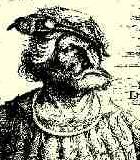 1395-1401. Klaus de Winsfield, a native of Hamburg, is harmed
by members of the Hanseatic League and swears vengeance against them. He
takes to the sea and becomes a pirate. For six years he preys on the merchant
ships of the League as well as against other pirates and other warships.
He becomes known as "Klaus Störtebecker." His base is in Heligoland,
and as time passes he allies with the feared Vitalis brothers and uses
his ship, the Ram, and his own secret store of Greek Fire, to help
the Vitalis brothers. Although he usually prowls the North Sea, some of
his adventures bring him farther abroad. He is known along the coasts of
the North Sea as the "Robin Hood of the waves," someone who helps the poor
and hates the rich. He is eventually captured by the forces of the League
and hanged. But his last request is that the authorities spare every man
of his crew who his headless body would walk past. Störtebecker's body
walked by all of his shipmates before collapsing, and every member of the
Ram's crew was saved. (Klaus Störtebecker, Der Gefürchtete
Herrscher der Meere #1-60, 1908-1909).
1395-1401. Klaus de Winsfield, a native of Hamburg, is harmed
by members of the Hanseatic League and swears vengeance against them. He
takes to the sea and becomes a pirate. For six years he preys on the merchant
ships of the League as well as against other pirates and other warships.
He becomes known as "Klaus Störtebecker." His base is in Heligoland,
and as time passes he allies with the feared Vitalis brothers and uses
his ship, the Ram, and his own secret store of Greek Fire, to help
the Vitalis brothers. Although he usually prowls the North Sea, some of
his adventures bring him farther abroad. He is known along the coasts of
the North Sea as the "Robin Hood of the waves," someone who helps the poor
and hates the rich. He is eventually captured by the forces of the League
and hanged. But his last request is that the authorities spare every man
of his crew who his headless body would walk past. Störtebecker's body
walked by all of his shipmates before collapsing, and every member of the
Ram's crew was saved. (Klaus Störtebecker, Der Gefürchtete
Herrscher der Meere #1-60, 1908-1909).
1491-1496. The Spanish knight Garcilas de la Vega, Lord
of Bartas, fights against the Moors but eventually gets on the wrong side
of the Inquisition. He sails to the New World with Christopher Columbus,
returns to Spain and marries his lady-love. (J. Breckenridge Ellis' Garcilaso,
1901).
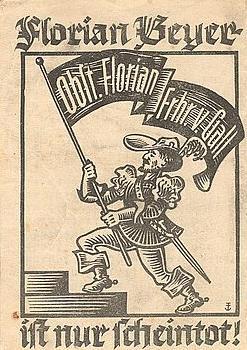 1524-1525. Across Germany many peasants rise up against oppressive
inheritance laws and unkind aristocrats. The revolt, which later becomes
known as the Peasants' War, is widespread, and although the peasants are
poorly armed and lack any kind of formal leadership, they posed a challenge
to the nobility. Initially the peasants only wanted to air their grievances
and negotiate a new legal status for themselves, but the Swabian nobility
betrayed the peasants and forced them into armed rebellion. The peasants
pressured local knights to lead them, but the peasants lacked suitable weaponry
and tactics and were no match for the cavalry and discipline of the aristocrats'
armies.
1524-1525. Across Germany many peasants rise up against oppressive
inheritance laws and unkind aristocrats. The revolt, which later becomes
known as the Peasants' War, is widespread, and although the peasants are
poorly armed and lack any kind of formal leadership, they posed a challenge
to the nobility. Initially the peasants only wanted to air their grievances
and negotiate a new legal status for themselves, but the Swabian nobility
betrayed the peasants and forced them into armed rebellion. The peasants
pressured local knights to lead them, but the peasants lacked suitable weaponry
and tactics and were no match for the cavalry and discipline of the aristocrats'
armies.
One of the leaders of the peasants during the war is Florian Geier.
In 1524 he leads a local group of peasants against a corrupt band of
thuggish knights. For the next year Geier's forces wage a successful
war, but in 1525 their siege of the castle of Giebelstadt, in Ingolstadt,
is broken. Later that year Geier is publicly executed, and the peasants'
rebellion comes to an end. (Florian Geier's Kampf mit den Raubrittern
#1-50, 1907).
This may not have been the end for Geier, however--see note #1 on the Notes page.
1568-1582. Medea da Carpi connives her way to the title
of Duchess of Stimigliano Orsini and then wife of Duke Guidalfonso II of
Urbania. Starting as a twelve year old and then dying as a twenty seven
year old, she uses lovers and husbands to gain power and then has them murdered,
or does the killing herself, to rid herself of them. She is beautiful and
manipulative and is so frightening that Duke Robert, the priest who eventually
defeats her, has her strangled by two infanticides and refuses to allow
her to be shriven before she dies, for fear that she would seduce the priest
who would grant her penitence. Duke Robert is so afraid of her, in fact,
that after he dies he has an image of his soul attached to his statue so
that the spirit of Medea could not haunt him and he could sleep peacefully
until Judgment Day. He is not entirely successful in this (see below).
(Vernon Lee's "Amour Dure," 1890).
 1570-1588. Captain Franz Drake sails the seas. The brother
of Sir Francis Drake, Franz leaves England at the same time as Francis
and follows roughly the same route for the same number of years, but Franz's
travels bring him to much more exotic locations, including "Cannibal Island"
off the coast of Chile, and into conflict with a much unusual adversaries,
including a tribe of female warriors along the Amazon river. However,
Franz preyed primarily on the enemies of England, especially the Spanish,
and robbed them and sank their ships. He became known as "the metal pirate"
due to the great amount of gold and silver he took from the Spanish. He
returned to England at the same time as his brother Francis and died fighting
the Spanish Armada. (Die Blutfahne der Flibustier #1-30, 1908).
1570-1588. Captain Franz Drake sails the seas. The brother
of Sir Francis Drake, Franz leaves England at the same time as Francis
and follows roughly the same route for the same number of years, but Franz's
travels bring him to much more exotic locations, including "Cannibal Island"
off the coast of Chile, and into conflict with a much unusual adversaries,
including a tribe of female warriors along the Amazon river. However,
Franz preyed primarily on the enemies of England, especially the Spanish,
and robbed them and sank their ships. He became known as "the metal pirate"
due to the great amount of gold and silver he took from the Spanish. He
returned to England at the same time as his brother Francis and died fighting
the Spanish Armada. (Die Blutfahne der Flibustier #1-30, 1908).
1585-1589. Gaston de Marsac, an impoverished French nobleman,
endures tribulations, danger, and wounds to gain true love and a Lieutenant
Governorship under King Henry IV of France. (Stanley Weyman's A Gentleman
of France, 1893).
1598-1610. Maximilien de Bethune, the Duc de Sully, uses
his not-inconsiderable wiles to help King Henry IV of France. (Stanley
Weyman's From the Memoirs of a Minister of France, 1895).
1600. The Italian mercenary Ugi di Savelli endures disgrace,
poverty, and starvation to find friendship (with Niccolo Machiavelli and
the Seigneur de Bayard) and preferment (with King Henry IV of France). (S.
Levett-Yeats' The Honor of Savelli, 1895).
1628. The feared Italian condottiere known as "the Unnameable"
is so touched by the innocence and purity of a peasant woman that he reforms
and swears to use his abilities for good rather than evil and greed. (Alessandro
Manzoni's I Promessi Sposi, 1825-1827).
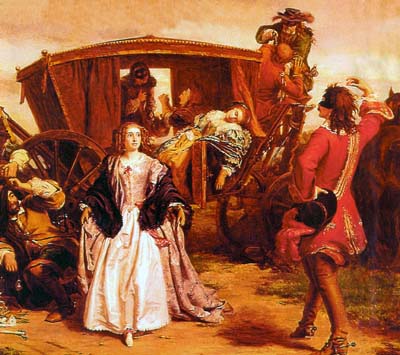 1660. Claude Duval begins his career as a "knight of the
road," a gentleman highwayman. Born in 1643, Duval moved to England during
the Restoration and worked as a footman for the Duke of Richmond. However,
he soon took to highway robbery. Duval was active on the roads to London
and targeted stagecoaches. Unlike most other highway robbers, Duval acted
in a gentlemanly manner, dressed fashionably, and reportedly never used
violence. He was known in his time for his courtly manners toward women,
supposedly dancing a coranto with a knight’s lady after robbing her husband,
and in another case agreeing to take only part of a gentleman’s money if his
wife agreed to dance with him. Duval was eventually arrested in a London tavern
and hanged in 1670.
1660. Claude Duval begins his career as a "knight of the
road," a gentleman highwayman. Born in 1643, Duval moved to England during
the Restoration and worked as a footman for the Duke of Richmond. However,
he soon took to highway robbery. Duval was active on the roads to London
and targeted stagecoaches. Unlike most other highway robbers, Duval acted
in a gentlemanly manner, dressed fashionably, and reportedly never used
violence. He was known in his time for his courtly manners toward women,
supposedly dancing a coranto with a knight’s lady after robbing her husband,
and in another case agreeing to take only part of a gentleman’s money if his
wife agreed to dance with him. Duval was eventually arrested in a London tavern
and hanged in 1670.
Or so the history books state. But the hidden history of the Wold
Newton Universe, that which has been overlooked, ignored, or suppressed
by authorities and historians, tells a much different story about Duval.
As the various stories and folktales state, Duval did right wrongs,
gamble, womanize, restores noblemen in trouble to their rightful estates,
succeed in hair’s-breadth escapes from the forces of law and order, and
in general lead a life of adventure. But his exploits went far beyond lighthearted
robbery, as shall be seen. (James Rymer's Claude Duval, the Dashing
Highwayman. A Tale of the Road #1-201, 1854).
Meanwhile, Gaspard, Comte de Chavagnac, begins his greatest
exploits, lasting until his death in 1679. He becomes famous across France
not only as a great military mind and general but also as one of the
country's finest swordsman and a valiant defender of the poor and downtrodden.
(Aventures et exploits du Comte de Chavagnac #1-5, 1913).
 1661-1672. Captain Henry Morgan conducts a nine-year career
of privateering and piracy against the Spanish, plundering Santiago (Chile)
in 1663, sacking Campeche, marching 50 miles overland to take Villahermosa,
and organizing over 1000 natives in taking the wealthy town of Grenada.
By 1670 Morgan was one of the greatest buccaneers, and his destruction
of Panama is one of the landmark events in the history of piracy. In 1672
Morgan returned to England and retired from piracy.
1661-1672. Captain Henry Morgan conducts a nine-year career
of privateering and piracy against the Spanish, plundering Santiago (Chile)
in 1663, sacking Campeche, marching 50 miles overland to take Villahermosa,
and organizing over 1000 natives in taking the wealthy town of Grenada.
By 1670 Morgan was one of the greatest buccaneers, and his destruction
of Panama is one of the landmark events in the history of piracy. In 1672
Morgan returned to England and retired from piracy.
So reads Morgan's official history. Different, less-respected and
unofficial accounts, from oral folktales to diaries, grant Morgan a more
heroic career. He fought numerous evil pirates, both Spanish and English,
including the dreaded Captain Satan. He left the Spanish Main and sailed
as far as Africa, where he overthrew the Tyrant of Zanzibar. And he helped
the natives of the Caribbean when he defeated the cannibals of Turtle Island.
(Unter Schwarzer Flagge #1-240, 1907-1910; Sous Le Pavillon Noir,
Les Aventures de Morgan Le Pirate #1-200, 1907-1911).
1665-1666. Claude Duval helps Paul Peril, the Red Hand,
the Red Avengers, and the dreaded Skeleton Horseman to defeat the evil
Black Band and the wicked schemes of King Charles II of England. Duval helps
Peril run away with Nell Gwynne. (The Skeleton Horseman, 1866).
 1698-1719. The black-hooded Beati Paoli wage a two decade-long
struggle against the power of both the Catholic Church and the Italian
government. Located in Palermo and named after "Beato Paola," Saint Francis
of Paolo, the Beati Paoli are a group of hooded "avengers" who (supposedly)
work for the common people against the Inquision, its spies, and the Austrian
government, which at this time controls the Sicilian throne. The Beati
Paoli are a fraternity of secret knights headquartered in the Capo district
of Palermo; they use a vast array of tunnels, sewers and hidden passageways
to secretly navigate the city. Their membership is unknown; they only
work by night, and appear dressed all in black and wearing hoods which
conceal their faces. (Luigi Natoli's Beati Paoli, 1909-1910).
1698-1719. The black-hooded Beati Paoli wage a two decade-long
struggle against the power of both the Catholic Church and the Italian
government. Located in Palermo and named after "Beato Paola," Saint Francis
of Paolo, the Beati Paoli are a group of hooded "avengers" who (supposedly)
work for the common people against the Inquision, its spies, and the Austrian
government, which at this time controls the Sicilian throne. The Beati
Paoli are a fraternity of secret knights headquartered in the Capo district
of Palermo; they use a vast array of tunnels, sewers and hidden passageways
to secretly navigate the city. Their membership is unknown; they only
work by night, and appear dressed all in black and wearing hoods which
conceal their faces. (Luigi Natoli's Beati Paoli, 1909-1910).
History states that the Beati Paoli eventually faded from power as
they continually failed to achieve their goals. But this is not so. The
truth is that the Beati Paoli were but one manifestation of an ongoing
struggle between conspirators in Sicily and the Italian government, one
which spanned not decades but centuries. As our colleague Dr. Lofficier
has described, from the
time of the Templars until the 20th century, a vast criminal conspiracy
was active in the Mediterranean. The modern struggle began in 1625,
with the murder of François Vitelli, heir to the title of Count
of Monteleone, by his jealous cousin Ercole Vitelli. This struggle culminated
in the triumph of Andrea Vitelli and the foundation of the Frères
de la Merci, which later become the fearsome "Black Coats" criminal
conspiracy. (Paul Féval's Bel Demonio, 1850).
Vitelli's whereabouts between 1655 and 1800 are not documented. But
evidence indicates that he, or one of his lieutenants, was involved in
taking an offshoot of the Frères de la Merci and transforming them
into the Beati Paoli. Furthermore, there is evidence to suggest that a later
offshoot approached Rinaldo Rinaldini (see below).
1700. The French writer and wit Mademoiselle de Scudéry,
as well-known for her devotion and goodness as for her novels, solves a
series of crimes plaguing Paris and helps an innocent man avoid execution.
(E.T.A. Hoffmann's “Das Fräulein von Scuderi,” 1819).
 1710-1721. Inspired by the example of Claude Duval, Louis-Dominique
Bourguignon takes to the roads of France and gains fame as the highwayman
Cartouche. What is not widely known is that Cartouche ventured
into England and carried out various gallant acts there. (Artheme Fayard's
Le Roi des Bandits #1-38, 1907-1908). It is not known whether he
ever enountered Dick Turpin (see below).
1710-1721. Inspired by the example of Claude Duval, Louis-Dominique
Bourguignon takes to the roads of France and gains fame as the highwayman
Cartouche. What is not widely known is that Cartouche ventured
into England and carried out various gallant acts there. (Artheme Fayard's
Le Roi des Bandits #1-38, 1907-1908). It is not known whether he
ever enountered Dick Turpin (see below).
1726. Ptolemy Horoscope works in London as an astrologer.
He lives in Little Britain, the “bibliopolitical part of London,” where
all the booksellers and publishers live. His landlady says that Horoscope
“tauld the fortunes o' a' the warld, for the people wad be coming in the
morn, and in the day-time, and in the dark night when naebody could see
them.” Horoscope does serve the public, but because his readings are so
accurate he is consulted by the highest in the land, even the nobility.
The stories hint that Horoscope has been a consultant to not just the loftiest
members of Parliament and the British royalty but also to foreign dignitaries.
But Horoscope serves all who come to him, down to the meanest members of
society. This includes Dick Turpin, who comes to Horoscope in 1726
(early in Turpin's criminal career) to find out what his fate will be. But
Horoscope is not home when Turpin comes to him for advice, so Horoscope's
assistant, Titus Parable, poses as Horoscope. Parable is greedy for lucre
and hopes for a reward from Turpin, but while Parable is giving Turpin a
false prediction, a mysterious, hollow voice speaks, predicting Turpin's
future. It is a true prediction, and it becomes clear that it was God who
spoke, and who Horoscope gets his predictions from. (Richard Thomson's Tales
of an Antiquary, 1828).
1728. The highwayman Macheath falls victim to the wiles
of the Peachums, receivers of stolen goods as well as willing collaborators
with a sinister thief-taker, Mr. Lockit. Lucy Lockit is Macheath's
sometime-lover; Polly Peachum is also in love with Macheath. (John
Gay’s Beggar’s Opera, 1728).
1731-1736. Joe Blake is a retired thief who works for the notorious
thief-taker and crime lord Jonathan Wild. Blake is known as “Blueskin”
because earlier in his life, during a crime, a gunpowder bomb had exploded
too near his head, coating half his face with a half blue, half purple
tint. A young Jack Sheppard, not yet entered into his life of crime,
approaches Blake for help; Blake was a friend of Tom Sheppard, Jack’s father,
and Blake knew Jack when he was young. Blake helps Jack enter Wild’s service,
and the pair hunt out Jacobite plotters while enriching themselves. Plot
complications ensue and Sheppard and Blake are forced to flee from Wild.
A long duel follows between them, with the usual hair’s-breadth escapes
and picaresque roguery. Wild’s villainy is eventually discovered and he
is hanged, and Sheppard and Blake escape to France and live on the wealth
of a friendly heiress. (Edward Viles’ Blueskin, 1866-7). (see note #2 on the Notes page)
1732. The highwayman Red Ralph carries on a successful
career as a highwayman. Among his friends and companions are Lucy Lockit
and Polly Peachum, intimates of Macheath; Elizabeth “Edgeworth
Bess” Lyon and Poll Maggot, friends of Jack Sheppard;
and the highwaymen Dick Turpin, Sixteen String Jack Rann,
Tom King, and Blueskin. (Percival Wolfe’s Red Ralph,
1866).
 1735. Sapathwa, “the Blue Dwarf,” is actually Baron Mountjoye.
His father, Lord Granville Seymour, left India before his pregnant wife
did. On her way home from Indian Lord Seymour’s wife, stranded in Malaysia,
gave birth to Sapathwa. But for various reasons Lord Seymour was not informed
of Sapathwa’s existence and “died in ignorance of his having a male heir.”
Sapathwa grows up in Malaysia with his mother and does not return home until
he is an adult, when he discovers that his underage cousin, Shelton Seymour
(who would be the rightful heir to the Seymour estates if Sapathwa did
not exist) is threatened by his evil brother, Brian Seymour. Sapathwa then
devotes himself to protecting Shelton from Brian. Toward this end Sapathwa
makes use of a number of agents, including Dick Turpin and Tom
King, who Sapathwa rescues from the Bow Street Runners and aids in various
ways. (Percy B. St. John’s The Blue Dwarf, 1874-1875). (see note #3 on the Notes page) The
Maypole Inn is mentioned as a location at which thieves such as Dick
Turpin meet. (Charles Dickens’ Barnaby Rudge, 1841).
1735. Sapathwa, “the Blue Dwarf,” is actually Baron Mountjoye.
His father, Lord Granville Seymour, left India before his pregnant wife
did. On her way home from Indian Lord Seymour’s wife, stranded in Malaysia,
gave birth to Sapathwa. But for various reasons Lord Seymour was not informed
of Sapathwa’s existence and “died in ignorance of his having a male heir.”
Sapathwa grows up in Malaysia with his mother and does not return home until
he is an adult, when he discovers that his underage cousin, Shelton Seymour
(who would be the rightful heir to the Seymour estates if Sapathwa did
not exist) is threatened by his evil brother, Brian Seymour. Sapathwa then
devotes himself to protecting Shelton from Brian. Toward this end Sapathwa
makes use of a number of agents, including Dick Turpin and Tom
King, who Sapathwa rescues from the Bow Street Runners and aids in various
ways. (Percy B. St. John’s The Blue Dwarf, 1874-1875). (see note #3 on the Notes page) The
Maypole Inn is mentioned as a location at which thieves such as Dick
Turpin meet. (Charles Dickens’ Barnaby Rudge, 1841).
1736. While Jack Sheppard and Blueskin are working
for Jonathan Wild, Dick Turpin helps the highwayman Captain
Heron to reform, marry the lovely Edith Tarleton, and become the new
Earl of Whitcombe. (James Malcolm Rymer’s Edith the Captive, 1860).
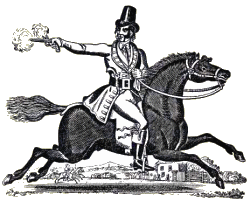 1737-1739. Dick Turpin's long and successful career as a
highwayman comes to an end. (Edward Viles’ Black Bess #1-254, 1863-1868).
Assisting Dick Turpin are his friends Sixteen String Jack Rann,
Tom King, Blueskin, Claude Duval, and Captain Hawk. (see note #4 on the Notes page)
1737-1739. Dick Turpin's long and successful career as a
highwayman comes to an end. (Edward Viles’ Black Bess #1-254, 1863-1868).
Assisting Dick Turpin are his friends Sixteen String Jack Rann,
Tom King, Blueskin, Claude Duval, and Captain Hawk. (see note #4 on the Notes page)
Claude Duval and Sixteen String Jack Rann help Wild
Will, a notorious bandit, carry out a brief career as a Thames Pirate.
(Charles H. Ross’ Wild Will, or The Pirates of the Thames, 1865).
1738. Tom King dies when he is accidentally shot during
a robbery by Dick Turpin. (Edward Viles’ Black Bess).
1739. Dick Turpin can no longer evade his fate and is
hanged for his crimes. (Edward Viles’ Black Bess). Following his
death Turpin is buried, but within a short time some body snatchers attempt
to steal his body. Captain Hawk rescues the body and gives it a
proper burial. After the burial Hawk and his wonderfully talented horse
Satan embark on the usual adventures of a highwayman. Hawk repeatedly duels
with a mysterious enemy who is eventually revealed to be Frederick, the
Prince of Wales. After numerous exploits Hawk and Frederick have been reconciled,
both win their lady-loves (Beatrice and Blanche), and Hawk is pardoned for
his crimes by Frederick. (Edward Viles’ The Black Highwayman, 1868-1869).
 1745-1755. Inspired by the examples of Claude Duval and Cartouche,
Louis Mandrin begins a decade-long career as a highwayman. Unknown
to the French public at large, Mandrin also travelled to England and adventured
there. (Mandrin, Roi des Voleurs #1-16, 1925).
1745-1755. Inspired by the examples of Claude Duval and Cartouche,
Louis Mandrin begins a decade-long career as a highwayman. Unknown
to the French public at large, Mandrin also travelled to England and adventured
there. (Mandrin, Roi des Voleurs #1-16, 1925).
1750. The Neapolitan Count Rosalvo takes on himself the onerous
task of ridding Venice of conspirators, thugs, and assassins. He does so
by using two assumed identities: one is Flodoardo, a handsome, virtuous
man who labors unceasingly to improve Venice; the other identity is Abällino,
a huge, monstrous and ugly outlaw. After some effort and difficulty he
is successful. (Heinrich Zschokke's Abällino der Große Bandit,
1794).
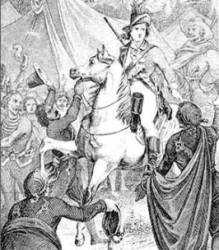 1770-1773. The noble-minded Corsican bandit Rinaldo Rinaldini
leads a gang of thieves in a rebellion against both the French control
of Corsica and the stifling conventions of modern society. Rinaldini is
successful for several years, but is eventually cornered by the "Schwarzen,"
the agents of the French government. Rinaldini commits suicide rather
than be hanged. (Christian Vulpius' Rinaldo Rinaldini, der Räuberhauptmann,
1799-1801).
1770-1773. The noble-minded Corsican bandit Rinaldo Rinaldini
leads a gang of thieves in a rebellion against both the French control
of Corsica and the stifling conventions of modern society. Rinaldini is
successful for several years, but is eventually cornered by the "Schwarzen,"
the agents of the French government. Rinaldini commits suicide rather
than be hanged. (Christian Vulpius' Rinaldo Rinaldini, der Räuberhauptmann,
1799-1801).
In 1772, while Rinaldini is masquerading as an Italian nobleman on
the mainland, he is approached by a sorcerer who claims to represent
"the Black Judges in Secret." This black-hooded group has grown "tired
of the yoke of tyrannical government" and are "resolved to rule ourselves."
They offer Rinaldini their leadership, but he declines it; his own experience
as leader of a gang of bandits and thieves was a negative one and disillusioned
Rinaldini about both the nature of men and his own effectiveness as a
leader. The Black Judges are later involved in an unsuccessful attempt
to overthrow the Corsican government.
The Black Judges are mentioned in the standard biography of Rinaldini,
but what is not often mentioned is the fact that the Black Judges are,
like the Beati Paoli (see above), another offshoot of the Black
Coats conspiracy. As Dr. Lofficier has described, Pasquale Paoli spent years
building up Corsica, only to have his efforts come to naught when
the French invaded the island in 1769. Paoli--and, surely, the name cannot
be a coincidence--fled to England and lived there for twenty years. But
he left behind a group of men who would not leave the island, and instead
fought on. This group failed, as did a later iteration, the Companions
of Silence. (Paul Féval's Les Compagnons du Silence, 1857).
1780-1781. Karl von Moor, the headstrong and passionate
son of the German Count von Moor, lets his emotions get the better of him
when he is disowned by his brother Franz. Karl leads a gang of bandits, and
many lives are lost and much heartbreak ensues before Karl's death. (Friedrich
Schiller's Die Räuber, 1781).
1785. An unnamed German Prince living in Venice is manipulated
by a mysterious Armenian. (Friedrich von Schiller's "Der Geisterseher," 1787-1789).
The Armenian is actually Cagliostro, a.k.a. Joseph Balsamo, who is
at the same time involved in the affair of Queen Marie-Antoinette's
necklace. (Alexandre Dumas' Le Collier de la Reine, 1849-1850).
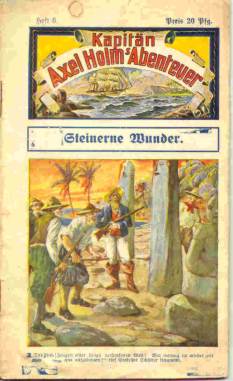 1786. Following the 1785 formation of the League of German Princes,
which initially includes Prussia, Electoral Saxony, and Hanover, but which
is later expanded to include Brunswick, Mainz, Hesse-Cassel, Baden, Mecklenburg,
Anhalt, and the Thuringian lands, the Prussian sea captain Axel Holm
begins a sea journey which will take five years and carry him around the
world. (Kapitän Axel Holm's Abenteuer #1-18, 1919-1920).
(see also 1937).
1786. Following the 1785 formation of the League of German Princes,
which initially includes Prussia, Electoral Saxony, and Hanover, but which
is later expanded to include Brunswick, Mainz, Hesse-Cassel, Baden, Mecklenburg,
Anhalt, and the Thuringian lands, the Prussian sea captain Axel Holm
begins a sea journey which will take five years and carry him around the
world. (Kapitän Axel Holm's Abenteuer #1-18, 1919-1920).
(see also 1937).
1789. Sir Percy Blakeney masquerades as a brainless fop while
carrying out extensive rescue operations for the French nobility as The
Scarlet Pimpernel. He is assisted by his wife Marguerite and the
League of the Pimpernel. (Baroness Emmuska Orczy's The Scarlet Pimpernel,
1905).
While the Pimpernel is aiding the nobility, Andre-Louis Moreau gains
fame killing them as Scaramouche. (Rafael Sabatini's Scaramouche,
1921). It is not recorded whether the two ever met.
During the French Revolution the Vicomte de Saux, a well-meaning
nobleman, is forced to choose between loyalty to the nobility, the
class into which he was born, and to the people of France, whose plight has
earned his sympathies. The Vicomte chooses the people, which spares him from
the attention of the Committees but alienates his friends and loved ones.
Eventually he is reunited with the woman he loves, Denise St. Alais, and they
survive the massacre at Nîmes and emigrate to England. (There is no
evidence that they were assisted in their escape by the Scarlet Pimpernel
or his League). (Stanley Weyman's The Red Cockade, 1896).
1790 In Ingolstadt, Germany, Victor Frankenstein creates
a Creature, an act which he quickly regrets. (Mary Shelley's Frankenstein,
1818).
1795. Father Ambrosio, the marvel of Madrid, the most learned
and saintly of all the monks of the city, is tempted by sex and falls prey
to sin, becoming a murderer and rapist. He is eventually tricked into selling
his soul to Satan, who then kills him. (M.G. Lewis' The Monk, 1796).
Timeline: 1801-1859.
Timeline: 1860-1900.
Timeline: 1901-1910.
Timeline: 1911-1920.
Timeline: 1921-1930.
Timeline: 1931-1945.
Notes.
Some Unknown Members
of the Wold Newton Family Tree.
 65-66 C.E. In Rome Vinicius, a Roman soldier, meets the maiden
Lygia, the daughter of a barbarian prince. Vinicius falls in love with
Lygia and through love of her eventually converts to Christianity. Meanwhile,
Vinicius’ friend Petronius negotiates his way through the deadly
politics of the court of Nero. He is known as "Petronius Arbiter" because
of his superb taste in art and aesthetics. Nero orders Rome set on fire
and begins persecuting the new cult of Christianity. Lygia is captured
but eventually freed, and Lygia and Vinicius marry and flee to Sicily.
The rogue manhunter Chilo Chilonides eventually escapes from Rome as well.
Petronius is not so lucky, although he could at any time depose Tigellinus,
the leader of the soldiers, and take command of the Roman army. (Such would
be too much effort for Petronius, who is content instead to stay in his
villa, admire his works of art, and read the classics. Knowing that he is
about to be condemned to death by Nero, Petronius holds a lush feast for
those he values. At the end of the feast he slits his wrist and then reads
a savage condemnation of Nero’s personality and artistic abilities. Petronius
dies in the arms of Eunice, his love. (Henryk Sienkiewicz's Quo Vadis,
1895).
65-66 C.E. In Rome Vinicius, a Roman soldier, meets the maiden
Lygia, the daughter of a barbarian prince. Vinicius falls in love with
Lygia and through love of her eventually converts to Christianity. Meanwhile,
Vinicius’ friend Petronius negotiates his way through the deadly
politics of the court of Nero. He is known as "Petronius Arbiter" because
of his superb taste in art and aesthetics. Nero orders Rome set on fire
and begins persecuting the new cult of Christianity. Lygia is captured
but eventually freed, and Lygia and Vinicius marry and flee to Sicily.
The rogue manhunter Chilo Chilonides eventually escapes from Rome as well.
Petronius is not so lucky, although he could at any time depose Tigellinus,
the leader of the soldiers, and take command of the Roman army. (Such would
be too much effort for Petronius, who is content instead to stay in his
villa, admire his works of art, and read the classics. Knowing that he is
about to be condemned to death by Nero, Petronius holds a lush feast for
those he values. At the end of the feast he slits his wrist and then reads
a savage condemnation of Nero’s personality and artistic abilities. Petronius
dies in the arms of Eunice, his love. (Henryk Sienkiewicz's Quo Vadis,
1895). 79. In Pompeii in the days before the eruption of Mount Vesuvius,
one man, above all others, is a figure of fear and respect: Arbaces,
"the Lord of the Burning Girdle." He is an Egyptian living in Pompeii.
A magician, he claims to be “he...from whom all cultivators of magic, from
north to south, from east to west, from the Ganges and the Nile to the
vales of Thessaly and the shores of the yellow Tiber, have stooped to learn.”
Worshipers of the Egyptian pantheon look to him as a priest, confessor,
and father figure; those who are not worshipers fear him, because he is
widely rumored to wield the Evil Eye. He has contacts everywhere, especially
among the Priests of Isis, whose chief Calenus is his servant and into
whose company Arbaces personally inducts a number of priests. None of this
is enough to save him when Vesuvius erupts, however. (Edward Bulwer-Lytton's
The Last Days of Pompeii, 1834).
79. In Pompeii in the days before the eruption of Mount Vesuvius,
one man, above all others, is a figure of fear and respect: Arbaces,
"the Lord of the Burning Girdle." He is an Egyptian living in Pompeii.
A magician, he claims to be “he...from whom all cultivators of magic, from
north to south, from east to west, from the Ganges and the Nile to the
vales of Thessaly and the shores of the yellow Tiber, have stooped to learn.”
Worshipers of the Egyptian pantheon look to him as a priest, confessor,
and father figure; those who are not worshipers fear him, because he is
widely rumored to wield the Evil Eye. He has contacts everywhere, especially
among the Priests of Isis, whose chief Calenus is his servant and into
whose company Arbaces personally inducts a number of priests. None of this
is enough to save him when Vesuvius erupts, however. (Edward Bulwer-Lytton's
The Last Days of Pompeii, 1834).  1395-1401. Klaus de Winsfield, a native of Hamburg, is harmed
by members of the Hanseatic League and swears vengeance against them. He
takes to the sea and becomes a pirate. For six years he preys on the merchant
ships of the League as well as against other pirates and other warships.
He becomes known as "Klaus Störtebecker." His base is in Heligoland,
and as time passes he allies with the feared Vitalis brothers and uses
his ship, the Ram, and his own secret store of Greek Fire, to help
the Vitalis brothers. Although he usually prowls the North Sea, some of
his adventures bring him farther abroad. He is known along the coasts of
the North Sea as the "Robin Hood of the waves," someone who helps the poor
and hates the rich. He is eventually captured by the forces of the League
and hanged. But his last request is that the authorities spare every man
of his crew who his headless body would walk past. Störtebecker's body
walked by all of his shipmates before collapsing, and every member of the
Ram's crew was saved. (Klaus Störtebecker, Der Gefürchtete
Herrscher der Meere #1-60, 1908-1909).
1395-1401. Klaus de Winsfield, a native of Hamburg, is harmed
by members of the Hanseatic League and swears vengeance against them. He
takes to the sea and becomes a pirate. For six years he preys on the merchant
ships of the League as well as against other pirates and other warships.
He becomes known as "Klaus Störtebecker." His base is in Heligoland,
and as time passes he allies with the feared Vitalis brothers and uses
his ship, the Ram, and his own secret store of Greek Fire, to help
the Vitalis brothers. Although he usually prowls the North Sea, some of
his adventures bring him farther abroad. He is known along the coasts of
the North Sea as the "Robin Hood of the waves," someone who helps the poor
and hates the rich. He is eventually captured by the forces of the League
and hanged. But his last request is that the authorities spare every man
of his crew who his headless body would walk past. Störtebecker's body
walked by all of his shipmates before collapsing, and every member of the
Ram's crew was saved. (Klaus Störtebecker, Der Gefürchtete
Herrscher der Meere #1-60, 1908-1909).  1524-1525. Across Germany many peasants rise up against oppressive
inheritance laws and unkind aristocrats. The revolt, which later becomes
known as the Peasants' War, is widespread, and although the peasants are
poorly armed and lack any kind of formal leadership, they posed a challenge
to the nobility. Initially the peasants only wanted to air their grievances
and negotiate a new legal status for themselves, but the Swabian nobility
betrayed the peasants and forced them into armed rebellion. The peasants
pressured local knights to lead them, but the peasants lacked suitable weaponry
and tactics and were no match for the cavalry and discipline of the aristocrats'
armies.
1524-1525. Across Germany many peasants rise up against oppressive
inheritance laws and unkind aristocrats. The revolt, which later becomes
known as the Peasants' War, is widespread, and although the peasants are
poorly armed and lack any kind of formal leadership, they posed a challenge
to the nobility. Initially the peasants only wanted to air their grievances
and negotiate a new legal status for themselves, but the Swabian nobility
betrayed the peasants and forced them into armed rebellion. The peasants
pressured local knights to lead them, but the peasants lacked suitable weaponry
and tactics and were no match for the cavalry and discipline of the aristocrats'
armies.  1570-1588. Captain Franz Drake sails the seas. The brother
of Sir Francis Drake, Franz leaves England at the same time as Francis
and follows roughly the same route for the same number of years, but Franz's
travels bring him to much more exotic locations, including "Cannibal Island"
off the coast of Chile, and into conflict with a much unusual adversaries,
including a tribe of female warriors along the Amazon river. However,
Franz preyed primarily on the enemies of England, especially the Spanish,
and robbed them and sank their ships. He became known as "the metal pirate"
due to the great amount of gold and silver he took from the Spanish. He
returned to England at the same time as his brother Francis and died fighting
the Spanish Armada. (Die Blutfahne der Flibustier #1-30, 1908).
1570-1588. Captain Franz Drake sails the seas. The brother
of Sir Francis Drake, Franz leaves England at the same time as Francis
and follows roughly the same route for the same number of years, but Franz's
travels bring him to much more exotic locations, including "Cannibal Island"
off the coast of Chile, and into conflict with a much unusual adversaries,
including a tribe of female warriors along the Amazon river. However,
Franz preyed primarily on the enemies of England, especially the Spanish,
and robbed them and sank their ships. He became known as "the metal pirate"
due to the great amount of gold and silver he took from the Spanish. He
returned to England at the same time as his brother Francis and died fighting
the Spanish Armada. (Die Blutfahne der Flibustier #1-30, 1908).  1660. Claude Duval begins his career as a "knight of the
road," a gentleman highwayman. Born in 1643, Duval moved to England during
the Restoration and worked as a footman for the Duke of Richmond. However,
he soon took to highway robbery. Duval was active on the roads to London
and targeted stagecoaches. Unlike most other highway robbers, Duval acted
in a gentlemanly manner, dressed fashionably, and reportedly never used
violence. He was known in his time for his courtly manners toward women,
supposedly dancing a coranto with a knight’s lady after robbing her husband,
and in another case agreeing to take only part of a gentleman’s money if his
wife agreed to dance with him. Duval was eventually arrested in a London tavern
and hanged in 1670.
1660. Claude Duval begins his career as a "knight of the
road," a gentleman highwayman. Born in 1643, Duval moved to England during
the Restoration and worked as a footman for the Duke of Richmond. However,
he soon took to highway robbery. Duval was active on the roads to London
and targeted stagecoaches. Unlike most other highway robbers, Duval acted
in a gentlemanly manner, dressed fashionably, and reportedly never used
violence. He was known in his time for his courtly manners toward women,
supposedly dancing a coranto with a knight’s lady after robbing her husband,
and in another case agreeing to take only part of a gentleman’s money if his
wife agreed to dance with him. Duval was eventually arrested in a London tavern
and hanged in 1670.  1661-1672. Captain Henry Morgan conducts a nine-year career
of privateering and piracy against the Spanish, plundering Santiago (Chile)
in 1663, sacking Campeche, marching 50 miles overland to take Villahermosa,
and organizing over 1000 natives in taking the wealthy town of Grenada.
By 1670 Morgan was one of the greatest buccaneers, and his destruction
of Panama is one of the landmark events in the history of piracy. In 1672
Morgan returned to England and retired from piracy.
1661-1672. Captain Henry Morgan conducts a nine-year career
of privateering and piracy against the Spanish, plundering Santiago (Chile)
in 1663, sacking Campeche, marching 50 miles overland to take Villahermosa,
and organizing over 1000 natives in taking the wealthy town of Grenada.
By 1670 Morgan was one of the greatest buccaneers, and his destruction
of Panama is one of the landmark events in the history of piracy. In 1672
Morgan returned to England and retired from piracy.  1698-1719. The black-hooded Beati Paoli wage a two decade-long
struggle against the power of both the Catholic Church and the Italian
government. Located in Palermo and named after "Beato Paola," Saint Francis
of Paolo, the Beati Paoli are a group of hooded "avengers" who (supposedly)
work for the common people against the Inquision, its spies, and the Austrian
government, which at this time controls the Sicilian throne. The Beati
Paoli are a fraternity of secret knights headquartered in the Capo district
of Palermo; they use a vast array of tunnels, sewers and hidden passageways
to secretly navigate the city. Their membership is unknown; they only
work by night, and appear dressed all in black and wearing hoods which
conceal their faces. (Luigi Natoli's Beati Paoli, 1909-1910).
1698-1719. The black-hooded Beati Paoli wage a two decade-long
struggle against the power of both the Catholic Church and the Italian
government. Located in Palermo and named after "Beato Paola," Saint Francis
of Paolo, the Beati Paoli are a group of hooded "avengers" who (supposedly)
work for the common people against the Inquision, its spies, and the Austrian
government, which at this time controls the Sicilian throne. The Beati
Paoli are a fraternity of secret knights headquartered in the Capo district
of Palermo; they use a vast array of tunnels, sewers and hidden passageways
to secretly navigate the city. Their membership is unknown; they only
work by night, and appear dressed all in black and wearing hoods which
conceal their faces. (Luigi Natoli's Beati Paoli, 1909-1910).  1710-1721. Inspired by the example of Claude Duval, Louis-Dominique
Bourguignon takes to the roads of France and gains fame as the highwayman
Cartouche. What is not widely known is that Cartouche ventured
into England and carried out various gallant acts there. (Artheme Fayard's
Le Roi des Bandits #1-38, 1907-1908). It is not known whether he
ever enountered Dick Turpin (see below).
1710-1721. Inspired by the example of Claude Duval, Louis-Dominique
Bourguignon takes to the roads of France and gains fame as the highwayman
Cartouche. What is not widely known is that Cartouche ventured
into England and carried out various gallant acts there. (Artheme Fayard's
Le Roi des Bandits #1-38, 1907-1908). It is not known whether he
ever enountered Dick Turpin (see below).  1735. Sapathwa, “the Blue Dwarf,” is actually Baron Mountjoye.
His father, Lord Granville Seymour, left India before his pregnant wife
did. On her way home from Indian Lord Seymour’s wife, stranded in Malaysia,
gave birth to Sapathwa. But for various reasons Lord Seymour was not informed
of Sapathwa’s existence and “died in ignorance of his having a male heir.”
Sapathwa grows up in Malaysia with his mother and does not return home until
he is an adult, when he discovers that his underage cousin, Shelton Seymour
(who would be the rightful heir to the Seymour estates if Sapathwa did
not exist) is threatened by his evil brother, Brian Seymour. Sapathwa then
devotes himself to protecting Shelton from Brian. Toward this end Sapathwa
makes use of a number of agents, including Dick Turpin and Tom
King, who Sapathwa rescues from the Bow Street Runners and aids in various
ways. (Percy B. St. John’s The Blue Dwarf, 1874-1875). (see note #3 on the Notes page) The
Maypole Inn is mentioned as a location at which thieves such as Dick
Turpin meet. (Charles Dickens’ Barnaby Rudge, 1841).
1735. Sapathwa, “the Blue Dwarf,” is actually Baron Mountjoye.
His father, Lord Granville Seymour, left India before his pregnant wife
did. On her way home from Indian Lord Seymour’s wife, stranded in Malaysia,
gave birth to Sapathwa. But for various reasons Lord Seymour was not informed
of Sapathwa’s existence and “died in ignorance of his having a male heir.”
Sapathwa grows up in Malaysia with his mother and does not return home until
he is an adult, when he discovers that his underage cousin, Shelton Seymour
(who would be the rightful heir to the Seymour estates if Sapathwa did
not exist) is threatened by his evil brother, Brian Seymour. Sapathwa then
devotes himself to protecting Shelton from Brian. Toward this end Sapathwa
makes use of a number of agents, including Dick Turpin and Tom
King, who Sapathwa rescues from the Bow Street Runners and aids in various
ways. (Percy B. St. John’s The Blue Dwarf, 1874-1875). (see note #3 on the Notes page) The
Maypole Inn is mentioned as a location at which thieves such as Dick
Turpin meet. (Charles Dickens’ Barnaby Rudge, 1841).  1737-1739. Dick Turpin's long and successful career as a
highwayman comes to an end. (Edward Viles’ Black Bess #1-254, 1863-1868).
Assisting Dick Turpin are his friends Sixteen String Jack Rann,
Tom King, Blueskin, Claude Duval, and Captain Hawk. (see note #4 on the Notes page)
1737-1739. Dick Turpin's long and successful career as a
highwayman comes to an end. (Edward Viles’ Black Bess #1-254, 1863-1868).
Assisting Dick Turpin are his friends Sixteen String Jack Rann,
Tom King, Blueskin, Claude Duval, and Captain Hawk. (see note #4 on the Notes page) 1745-1755. Inspired by the examples of Claude Duval and Cartouche,
Louis Mandrin begins a decade-long career as a highwayman. Unknown
to the French public at large, Mandrin also travelled to England and adventured
there. (Mandrin, Roi des Voleurs #1-16, 1925).
1745-1755. Inspired by the examples of Claude Duval and Cartouche,
Louis Mandrin begins a decade-long career as a highwayman. Unknown
to the French public at large, Mandrin also travelled to England and adventured
there. (Mandrin, Roi des Voleurs #1-16, 1925).  1770-1773. The noble-minded Corsican bandit Rinaldo Rinaldini
leads a gang of thieves in a rebellion against both the French control
of Corsica and the stifling conventions of modern society. Rinaldini is
successful for several years, but is eventually cornered by the "Schwarzen,"
the agents of the French government. Rinaldini commits suicide rather
than be hanged. (Christian Vulpius' Rinaldo Rinaldini, der Räuberhauptmann,
1799-1801).
1770-1773. The noble-minded Corsican bandit Rinaldo Rinaldini
leads a gang of thieves in a rebellion against both the French control
of Corsica and the stifling conventions of modern society. Rinaldini is
successful for several years, but is eventually cornered by the "Schwarzen,"
the agents of the French government. Rinaldini commits suicide rather
than be hanged. (Christian Vulpius' Rinaldo Rinaldini, der Räuberhauptmann,
1799-1801).  1786. Following the 1785 formation of the League of German Princes,
which initially includes Prussia, Electoral Saxony, and Hanover, but which
is later expanded to include Brunswick, Mainz, Hesse-Cassel, Baden, Mecklenburg,
Anhalt, and the Thuringian lands, the Prussian sea captain Axel Holm
begins a sea journey which will take five years and carry him around the
world. (Kapitän Axel Holm's Abenteuer #1-18, 1919-1920).
(see also 1937).
1786. Following the 1785 formation of the League of German Princes,
which initially includes Prussia, Electoral Saxony, and Hanover, but which
is later expanded to include Brunswick, Mainz, Hesse-Cassel, Baden, Mecklenburg,
Anhalt, and the Thuringian lands, the Prussian sea captain Axel Holm
begins a sea journey which will take five years and carry him around the
world. (Kapitän Axel Holm's Abenteuer #1-18, 1919-1920).
(see also 1937).